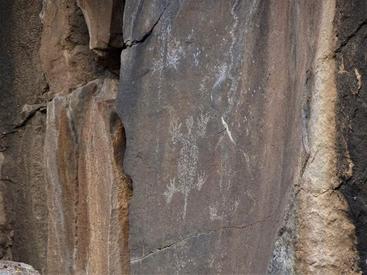A different way of knowing
First you have to understand about rain….The gift of rain the Kokkos brings is like a blessing. Snow is a promise. – Virgil Wyaco, Zuni Tribe
Virgil’s description a desert is in sharp contrast with the Oxford English Dictionary definition: A dry, barren area of land, especially one covered with sand, that is characteristically desolate, waterless, and without vegetation. One is a statement of opportunity, the other a statement of a place with little to offer a European visitor. One comes from centuries upon centuries of living in a place; the other based on second-hand accounts of those who made brief forays into deserts in search of resources to exploit. The lack of obvious resources allowed the desert dwelling tribes a bit longer to exist with their pre-contact culture intact before the wave of European-origin explorers and settlers changed everything.
These first humans to live in the western hemisphere, are not a single culture, they are a collection of perhaps hundreds, maybe thousands, of cultures who found a way to exist and coexist within the exceptional diversity of landscapes that comprised what we now call North and South America. They did not develop a scientific perspective as we would think of it today, but their lives depended on knowing the animals and plants that shared their world. They needed to know where the plants and animals lived, their habitats, and they needed to know what factors caused their numbers to fluctuate with and between years. Sounds like science. But it was a different way of knowing, knowledge passed through generations through story telling.
Lizards play positive roles in the folklore of many Native American tribes. In Plains Indian tribes, lizards are associated with healing and survival, and also with masculinity. In some Plains tribes, a newborn boy's umbilical cord was sewn into an amulet in the shape of a lizard to ensure his health and strength. Today, many Cheyenne people still consider it bad luck to kill a lizard. In the mythology of some California Indian tribes, such as the Pomo, Lizard was one of the major figures of creation, who made humans partially in his image. In Southwestern tribes, horned lizards are considered sacred medicine animals. In other tribes, lizards are associated with protection (especially of children), prosperity, renewal, and good luck. In one Navajo story, Coyote tries to play a game with a group of lizards who are sliding downhill on rocks. They warn Coyote that this is a game for lizards, and he is too large and will probably be injured. Ignoring their warning, Coyote slides on a large rock that flips and lands on him. As an act of kindness, and as a way to clear him from the playing field, the lizards circle around him and use their power to bring him back to life. These reptiles are also seen as a sign of luck. Perhaps their ability to survive in the harsh climate of the desert led to this belief. It may also be that their ability to hide quickly made it a good omen to see one. Whatever the reason, different tribes demonstrate the importance of this animal in several ways. As an example, some tribes of the Great Plains tie the umbilical cord of a newborn boy into a lizard-like shape. This symbol is supposed to give the boy enhanced fortune, healing, and masculinity. Due to their ability to regenerate, people consider these creatures as a link between the human world and the spirit world. In a creation story of the Pomo tribe of northwestern California, Lizard and Coyote wrestle to decide how human beings should appear. Because the reptile wins, human beings are given hands with fingers rather than paws.
Among the tribes of the Southwest like the Navajo and Hopi, Gila Monster is known as a powerful and magical figure. His hard scales keep him safe from all sorts of danger. He is sacred to medicine men for his ability to understand injuries and protect against them. They tell stories of Gila Monster stepping into battle and bringing fallen warriors back to life. There are also stories of warriors who went to battle wearing armor in the distinctive black and yellow pattern of Gila Monster.
The Hopi tribe celebrates a figure known as Monongya Katsina. Like all of the Katsinas, Monongya acts as a link between the spiritual and the human. In ceremonial dances, he arrives wearing a mask with the turquoise color of the eastern collared lizard. This species is known for its bright appearance and quick speed. Monongya is a warrior who encourages the people to act like true Hopi. In many ceremonies, it is his job to chastise those who act foolishly. He is also known for his matchmaking skills. This Hopi warrior and his smaller relatives in the desert remind the people that they are part of a sacred landscape.
These different ways of knowing animals and plants adds new color and awareness to the natural world.
Nullius in verba
Go outside, tip your hat to a chuckwalla (and a cactus), think like a mountain, and be safe.
